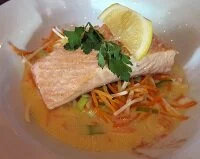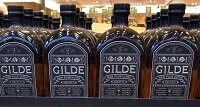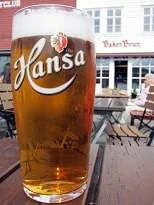When & Where to Eat
Norwegians generally begin the day with a cup of coffee and perhaps a small breakfast. This is typically eaten at home and the food is rarely more than simple cold foods that don't take any preparation time. This may include bread, jam, cheese, cereal, and even open faced sandwiches. Due to work schedules today mid-day meals vary somewhat, but most people will have another small cold meal at work taken at about noon. Again this meal is fairly simple and generally consists of leftovers as open faced sandwiches are common.
The main meal of the day is eaten at about 4:00-6:00 pm and is known as middag. This meal is changing somewhat as many people work until 5:00 or 6:00 pm and may not get home until even later. No matter when it is eaten though, it is the largest meal of the day and often consists of a protein, such as fish, mutton, or meatballs with potatoes and vegetables. This meal is usually eaten in the home with family, but going out to eat in Norway is popular, so many people will go out for meal.
For those who eat an earlier middag meal a late evening snack, usually consisting of leftovers, is eaten. As more people work later and hence eat their middag later, this evening snack is becoming less popular.
Staple Foods
Bread: nearly every Norwegian includes bread in their dining routine, especially for breakfast and lunch
Cheese: cheese remains a common ingredient in dishes or can be served alone
Regional Variations, Specialties, & Unique Dishes
Gammelost: sour milk cheese
Kjottkaker: fried meat balls served with gravy, mashed peas, and potatoes
Lutefisk: dried cod or ling marinated in lye to preserve it; more of a traditional food than an everyday meal
Pinnekjott: salted, dried, and sometimes smoked lamb ribs; common for Christmas meal
Rakfisk: fermented fish
Dining Etiquette

Salmon
Although being invited into a Norwegian's home is rare, if you do get an invitation, arrive on time and bring a small gift, such as chocolates, pastries, or wine. Also be sure to dress conservatively; despite the liberal nature of the country, dressing nicely is a sign of respect so do so, especially if you're at a business meeting or dining in a local's home. Once you arrive, look to see if you should remove your shoes and shake everyone's hand, even children. If the host is still preparing the meal, offer to assist with the preparation although this offer will often times be turned down.
Your host may have a seating arrangement so wait to take a seat until invited to do so. Once seated, the Norwegians are somewhat formal, but before the formalities many meals will begin with a toast. If there are toasts, make eye contact throughout the toast and once finished drinking women traditionally put their glasses down before men do. Toasts are typically only made with hard alcohol or wine, not beer, but this depends on the situation and your company.
The entire time you are at the table you should keep your hands within sight; the easiest way to do this is by resting your wrists on the edge of the table. When eating though use the continental style (the knife in the right hand, fork in the left: don't switch hands) and wait to begin eating until your host begins or invites you to start. It's considered polite to try everything offered so grab a little of everything; if you have a food allergy or other dietary restrictions try to mention this when you are invited to dine as turning it down now is a bit rude, but will be understandable and accepted as the Norwegians are generally too polite to make much of a fuss. Once you're finished eating, and do eat everything on your plate, place your fork and knife together in the 5:25 position.
 Aquavit
Aquavit
Expect dinner to be followed with conversation and don't rush out after a meal, neither in a home nor in a restaurant as socialization is an important part of every meal. If you are in a restaurant, the inviter is expected to pay for everyone, but the guest should reciprocate by inviting the host out to a later meal.
Most Norwegian restaurants will include a service charge of 10% to the bill, but rounding up is a common gesture for good service. In Oslo and other large cities tipping is growing in popularity and you should add another 5-10% for good service so the total tip falls in the 15-20% range; for poor service, no additional tip is needed. In small towns, tipping is an odd custom and is not expected so just pay the standard 10% service charge, which should already be on most bills.
Drinks

Hansa Beer
Like many other Scandinavians, the Norwegians love coffee and most places will have long lines to get some each morning. It is also used as an excuse to socialize and get together, which makes coffee popular throughout the day. Norway offers nearly every other popular international non-alcoholic drink like juices, tea, and soft drinks.
Aquavit is one of the most unique drinks in Norway; it is an alcohol distilled from potatoes and flavored with anise and caraway, although many times it is flavored with additional, or different, spices. Beer, however is the most commonly drunk alcohol as there are numerous microbrews in the country. Vodka is also common as it is in other Nordic countries. Although wine isn't produced in Norway, it is easily accessible in shops and at nice restaurants throughout the country.
Generally speaking, the tap water is safe to drink in Norway, but check with locals for any particular regional differences. Also, many people may have troubles adjusting to the local tap water, as it will most certainly be different from what your system is used to.